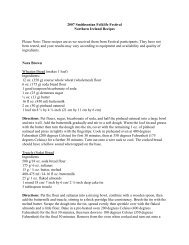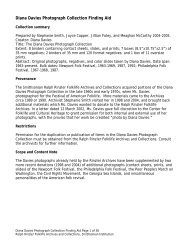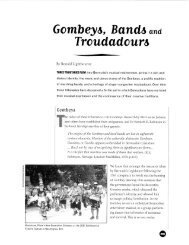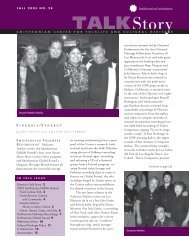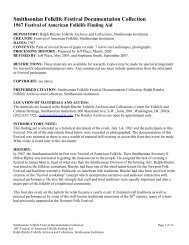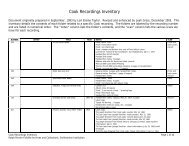Who Owns Traditional Medical Knowledge? - Smithsonian Center ...
Who Owns Traditional Medical Knowledge? - Smithsonian Center ...
Who Owns Traditional Medical Knowledge? - Smithsonian Center ...
You also want an ePaper? Increase the reach of your titles
YUMPU automatically turns print PDFs into web optimized ePapers that Google loves.
166 SITA REDDY<br />
focused on emerging market trends such as Ayurvedic tourism and the sale of<br />
proprietary Ayurvedic medications worldwide. 21 My argument then was that ethnomedical<br />
tourism or the selling of place-based heritage to global audiences prefigured<br />
ways in which local medical practices would be revived in the twenty-first<br />
century. The underlying subtext was that the global market would save this tradition<br />
from loss, not nationalist revivals of practice or institutionalized reform of<br />
Ayurvedic education, which had been judged a professionalizing failure. 22 The logic<br />
of the market, in my view then, would even create new forms of local authenticity.<br />
From what I observed, Ayurveda was reinvented for global audiences not just as a<br />
transnational medical system but as a transnational cultural form or “ideoscape,”<br />
an ethnomedical cure for disease as well as modernity, healing the West not just<br />
through medical efficacy but through cultural difference. 23 Here, in other words,<br />
was a sort of Orientalism in reverse, a market Occidentalism that encouraged the<br />
global circulation of Ayurvedic goods on the premise that this heritage belonged<br />
not to India alone but to all humanity: a phenomenon that John Merryman, referring<br />
to another context and era had termed “cultural internationalism.” 24<br />
Over the last few years, that prediction proved to be only partially right, and<br />
therefore partially wrong. I was wrong on two counts. First, I had not foreseen the<br />
considerable role that would be played not by the market but by the state in the<br />
production of Ayurvedic heritage. Here, I broadly define state to mean “state practices”<br />
in James Scott’s sense of the term—as the “technologies of state, knowledge<br />
practices and law” that include governance by international, national, or subnational<br />
entities but also, conversely, indigenous forms of resistance that speak<br />
back to the state in the same idiom. 25 Scott’s thesis about knowledge practices, in<br />
particular practical knowledge or metis, describes the perils of a marriage between<br />
powerful states and high modernism. When powerful states undertake modernizing<br />
projects, their simplification of complex knowledge prepares the way for disasters<br />
to unfold. Postcolonial knowledge practices in this sense are similar to what<br />
Timothy Mitchell calls “the rule of experts”—the governmentality of heritage that<br />
foregrounds ways in which power structures knowledge, in which power produces<br />
knowledge through difference, much as colonial knowledge practices and archives<br />
once did. 26<br />
Needless to say, this production of state-based Ayurvedic heritage schemes did<br />
not occur in a policy vacuum. In five short years, transformative shifts in indigenous<br />
rights movements and sustainable development strategies have managed to<br />
change the international heritage policy environment considerably. Recent UN legal<br />
instruments and national laws in an increasing number of signatory nations have<br />
helped to redefine medical and genetic heritage as cultural property owned by<br />
nation-states and local communities. The 2003 Convention to Safeguard the Intangible<br />
Cultural Heritage (CSICH) encourages the creation of inventories and<br />
databases of TMK by signatory nations. 27 Ownership and control over TMK and<br />
biodiversity have become the new realities and tropes of medical globalization. If<br />
anything, the trend now is a move away from cultural internationalism and to-



